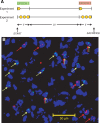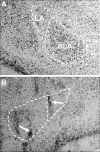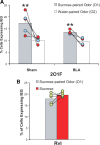Associatively learned representations of taste outcomes activate taste-encoding neural ensembles in gustatory cortex
- PMID: 20007463
- PMCID: PMC2823084
- DOI: 10.1523/JNEUROSCI.3233-09.2009
Associatively learned representations of taste outcomes activate taste-encoding neural ensembles in gustatory cortex
Abstract
Through learning processes, cues associated with emotionally salient reinforcing outcomes can come to act as substitutes for the reinforcer itself. According to one account of this phenomenon, the predictive cue associatively elicits a representation of the expected outcome by reactivating cells responsible for encoding features of the primary reinforcer. We tested this hypothesis by examining the role of neural ensembles in gustatory cortex (GC) during receipt of gustatory stimuli (sucrose and water) and cues associated with those stimuli using the immediate early genes (IEGs) Arc and Homer1a. Because these plasticity-related IEGs are expressed in the neuronal nucleus 5 and 30 min, respectively, after salient events, we examined how individual neurons encoded these stimuli in two separate behavioral epochs. In experiment 1, we showed that tasting identical sucrose solutions, but not tasteless water, in the two epochs increased both IEG activity and the degree of overlap between neural ensembles in GC. In experiment 2, odor cues associated with sucrose, but not water, evoked potentiation of IEG activity in GC similar to sucrose itself. Surprisingly, lesions of the basolateral amygdala had minimal effects on associative encoding in GC. Finally, these associatively driven representations of sucrose appeared to be outcome specific, as neural ensembles that were activated by the sucrose-associated cue were also activated by sucrose itself. This degree of overlap between associative and primary taste activity at the ensemble level suggests that GC neurons encode important information about anticipated outcomes. Such representations may provide outcome-specific information for guiding goal-directed behavior.
Figures







Similar articles
-
Flavor preference learning increases olfactory and gustatory convergence onto single neurons in the basolateral amygdala but not in the insular cortex in rats.PLoS One. 2010 Apr 9;5(4):e10097. doi: 10.1371/journal.pone.0010097. PLoS One. 2010. PMID: 20404918 Free PMC article.
-
Processing of Intraoral Olfactory and Gustatory Signals in the Gustatory Cortex of Awake Rats.J Neurosci. 2017 Jan 11;37(2):244-257. doi: 10.1523/JNEUROSCI.1926-16.2016. J Neurosci. 2017. PMID: 28077705 Free PMC article.
-
Single-neuron responses to intraoral delivery of odor solutions in primary olfactory and gustatory cortex.J Neurophysiol. 2017 Mar 1;117(3):1293-1304. doi: 10.1152/jn.00802.2016. Epub 2016 Dec 21. J Neurophysiol. 2017. PMID: 28003413 Free PMC article.
-
Coding in the mammalian gustatory system.Trends Neurosci. 2010 Jul;33(7):326-34. doi: 10.1016/j.tins.2010.04.002. Epub 2010 May 20. Trends Neurosci. 2010. PMID: 20493563 Free PMC article. Review.
-
Behavioral modulation of gustatory cortical activity.Ann N Y Acad Sci. 2009 Jul;1170:403-6. doi: 10.1111/j.1749-6632.2009.03922.x. Ann N Y Acad Sci. 2009. PMID: 19686167 Free PMC article. Review.
Cited by
-
GABA-Mediated Inactivation of Medial Prefrontal and Agranular Insular Cortex in the Rat: Contrasting Effects on Hunger- and Palatability-Driven Feeding.Neuropsychopharmacology. 2016 Mar;41(4):960-70. doi: 10.1038/npp.2015.222. Epub 2015 Jul 23. Neuropsychopharmacology. 2016. PMID: 26202102 Free PMC article.
-
Targeted effects of ketamine on perceptual expectation during mediated learning in rats.Psychopharmacology (Berl). 2022 Aug;239(8):2395-2405. doi: 10.1007/s00213-022-06128-2. Epub 2022 Apr 7. Psychopharmacology (Berl). 2022. PMID: 35389087 Free PMC article.
-
Dynamic Representation of Taste-Related Decisions in the Gustatory Insular Cortex of Mice.Curr Biol. 2020 May 18;30(10):1834-1844.e5. doi: 10.1016/j.cub.2020.03.012. Epub 2020 Apr 2. Curr Biol. 2020. PMID: 32243860 Free PMC article.
-
Sensory Cortical Activity Is Related to the Selection of a Rhythmic Motor Action Pattern.J Neurosci. 2016 May 18;36(20):5596-607. doi: 10.1523/JNEUROSCI.3949-15.2016. J Neurosci. 2016. PMID: 27194338 Free PMC article.
-
Role of amygdala central nucleus in aversive learning produced by shock or by unexpected omission of food.J Neurosci. 2012 Feb 15;32(7):2461-72. doi: 10.1523/JNEUROSCI.5090-11.2012. J Neurosci. 2012. PMID: 22396420 Free PMC article.
References
-
- Allen GV, Saper CB, Hurley KM, Cechetto DF. Organization of visceral and limbic connections in the insular cortex of the rat. J Comp Neurol. 1991;311:1–16. - PubMed
Publication types
MeSH terms
Substances
Grants and funding
LinkOut - more resources
Full Text Sources
Medical
Molecular Biology Databases
Miscellaneous
